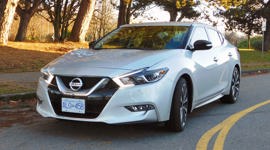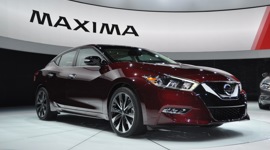The all-new 2016 Nissan Maxima is about as sleek as a four-door sedan can be. Nissan designers have stretched (by 56 millimeters) and lowered (by 33 mm) their flagship model to create a clearly sports-oriented vehicle with an abundance of what dealers call “eyeball”. Impressive from all angles, it's the side profile that stands out with its high waistline, Nissan signature “floating” roof and sinuous lines front to rear. No doubt about it, this car turns heads.
The all-new 2016 Nissan Maxima is about as sleek as a four-door sedan can be.
But as you may know, large four-door sedans are no longer as popular as they once were. What are people buying instead? You might think SUVs, but mostly, according to Nissan Canada Chief Marketing Manager Andrew Wilton, sales are migrating to V6-powered midsize sedans. People are downsizing from large, Maxima-style sedans, in other words.
Nonetheless, there is a market – albeit declining – for the big cars, and in the 2016 Maxima, Nissan is offering tremendous value in the form of “class above” standard and optional equipment to complement its very appealing design.
There are four trim levels and no options. It's an unusual approach to selecting the features you want, but it enables buyers to choose the Maxima “flavour” they like and be assured that key features are included as standard equipment. The model ladder starts at the $35,900 SV and moves up via the $38,950 SL and $41,100 SR to the $43,300 Platinum.
Under the hood of all Maximas is a re-engineered 3.5L VQ engine fitted with 60 percent new components and now making 300 hp at 6,400 rpm and 261 lb-ft of torque at 4,400 rpm. The transmission is a new generation sport-tuned CVT “automatic.” The chassis is lighter and stiffer (a 25 percent increase in torsional rigidity). Although the Maxima is larger in size and the engine is more powerful compared with the outgoing model, fuel economy is improved by 15 percent to 10.9/7.8/9.5 L/100km city/highway/combined.
The base Maxima SV offers a suite of standard equipment, some of which could be optional even on entry-level luxury competitors. Standard equipment includes “Nissan Connect” Navigation with Mobile Apps and voice activation, heated and power assisted front seats, heated steering wheel, 18-inch wheels, heated outside mirrors with LED turn signal repeaters, satellite radio with traffic information, leather interior, Intelligent Key with push-button start and rear-view monitor.
More on autoTRADER: Nissan Maxima Moves into Sport Sedan Territory
Additional equipment is comprehensive, and varies depending on the trim level. All levels except for the SV, for instance, get desirable safety and security features including Blind Spot Warning, Intelligent Cruise Control, Rear Cross Traffic Alert, Predictive Forward Collision Warning and Forward Emergency Braking. They are also equipped with the Bose premium-level audio system.
The sporty SR gets sport-tuned suspension, 19-inch alloy wheels, Alcantara-finished door panels, an Integrated Dynamic-control Module with Active Ride Control and paddle shifters. No dual-pane panorama roof, however (no sunroof at all, in fact, for the sporty SR in an effort to maximize chassis rigidity).
The top-level Platinum gets the fancy roof (as does the SL) but also gets quilted Ascot leather seat surfaces, ventilated front seats, around-view monitor, rain sensing windshield wipers, power tilt and telescoping steering column and “NissanConnect Services” (an OnStar-like service that includes automatic collision notification, remote start via smartphone, emergency call, stolen vehicle locator, alarm notifications and maintenance alerts). Moving Object Detection and Driver Alert Warning (monitors driver alertness, sounds a gentle alarm if it detects driver fatigue) are added to the safety suite.
As I say, the buyer selects the model that most closely meets his or her needs, simplifying the buying process for consumer and dealer, and the production process for the manufacturer. This approach does preclude tailoring a car to specific requirements, however.
Positioned as a “four-door sports car for driving enthusiasts,” Maxima is predominantly targeted to middle-age males who enjoy driving and who prefer a product that stands out. No doubt a factor for its debuted in a dramatic 2015 Super Bowl ad. For the first time, Maxima offers Drive Select, in which the driver can toggle between Normal and Sport modes. In Sport mode, the engine throttle response increases, the Xtronic transmission programming changes for more aggressive shifting under braking and gear holding, the steering weight increases and the Active Sound Enhancement system further amplifies the engine note in the cabin.
Featured in the sporty Maxima SR, the Integrated Dynamic-control Module (IDM) mentioned above adds enhanced electronic chassis management to the Maxima. Active Ride Control, a feature within IDM, applies minute brake applications after the vehicle encounters a bump or undulation to immediately correct the level of the body. The technology allows the SR to simultaneously offer sport handling and a compliant ride on most road surfaces.
Inside, Maxima's cockpit is inspired by aviation (The US navy's Blue Angel jet fighters, no less). It's fully redesigned and features a centre stack that's angled toward the driver (à la GTR) and a “floating” console that is placed higher than the previous generation Maxima to ensure that key controls are within easy reach. Even the start button is positioned more conveniently next to the gearshift. Contrasting stitching and rich padding are evident throughout and a new Display Commander control is located on the centre console that duplicates functions found on the touchscreen display. The Display Commander control is a smart piece of design that falls readily to hand and is appealing both in look and feel.
The seats and interior panels are also impressively designed and rendered. Trim panels on the dash and doors are interestingly faceted and vary from wood (not too much gloss) to matte metal depending on the trim level. This interior is more British than American or German, although not overwrought with wood and fussy switchgear. Looking at the Platinum's quilted seats my first thought was… dare I say it? Bentley. Check out the knurled metal knobs as well. There’s definitely some Bentley inspiration there.
We drove the Platinum and SR models on multi-lane highways and on the narrow, twisting roads of Quebec’s Laurentians. The car is smooth, quiet, powerful and comfortable. I imagine it would be a superb long-distance vehicle.
Fit and finish inside is excellent, the materials appear first-rate and the design is likewise of a high order. Everything looks and feels quality, which is great given the very competitive Maxima pricing. It would be nice if the proximity sensors could tell the difference between grass and a brick wall, however.
Taller drivers will love the range of seat adjustability. The front seat goes way back; I reckon Andrew Wiggins would have no problem in this car. On the other hand, folks of normal stature will be well served. Outward visibility is good and the controls are logically placed, easy to find, identify and use. The touchscreen display and control module between the seats are also uncomplicated and intuitive.
Rear seat room is cavernous. If ever one does need to transport three to five people, the rear seat occupants will have plenty of space.
Happily, Maxima drives smaller than it looks. The car feels light and nimble; no more challenging to drive than a compact, really. The Platinum with its big sunroof and responsive but relaxed driving dynamics impresses with its smoothness and quiet cabin. We achieved about 8.8 L/100km on our 200 km drive route.
The SR offers a significantly different experience with a stiffer suspension and quicker steering. The Sport mode ups the ante even more. It’s a genuinely noticeable step into performance territory as the exhaust rouses, the steering stiffens and the throttle quickens appreciably. My favourite, even without the sunroof, was the SR in Normal mode. Only on uneven and broken pavement did its suspension seem choppy. In normal driving conditions it was super smooth and on those twisty roads the car impressed with its balance and poise. Fun to drive, in fact, which is exactly what Nissan intended.
While Maxima buyers are apparently mostly male, I can’t see why women wouldn’t want to give this car a look. It has presence but it’s not brash; it’s got power but it’s controlled and unobtrusive; the SR has an exhaust note but only in Sport mode; the vehicle feels secure and safe; the equipment is generous, build quality is excellent and design is tasteful and modern.
All in all, the 2016 Nissan Maxima offers a great deal to consumers... if one is in the market for a large sedan. Apparently, not many are (Nissan Canada sold about 1,000 Maximas in 2014). Maybe this eighth-generation Maxima will buck the trend. It’s absolutely worth a look if you’re sedan shopping. Competitors are the Chevrolet Impala and Toyota Avalon and possibly entry-luxury buyers checking out the Audi A4 and BMW 3 Series. They start at the same price point but lack the standard equipment.
2016 Nissan Maxima
Origin: Smyrna, Tennessee.
Available: Summer, 2015






























